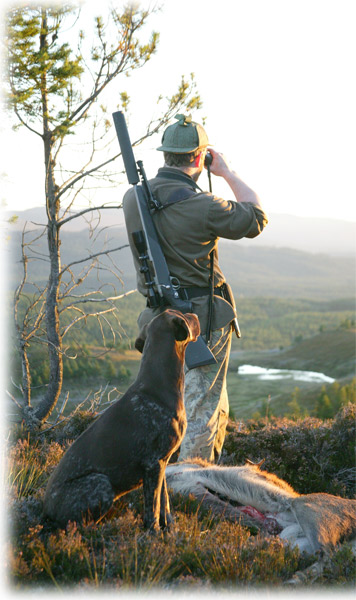Aim
This guide aims to identify different models of letting deer stalking. In particular it will:
- identify the advantages and disadvantages of differing lease models;
- highlight the issues to consider when letting stalking; and
- identify the key elements required when formulating a legally binding lease.
Why lease?

The main reasons for leasing stalking are to:
- Generate income;
- Provide additional labour input into achieving culls without cost;
- Provide assistance in achieving management objectives.
Deer have an economic value both as a sporting asset and for the venison they produce. Frequently land owners/managers find themselves balancing utilisation of deer as a resource and keeping negative deer impacts to minimum. This is particularly relevant to woodland deer management and/or land with land features sensitive to deer impacts. Where minimising the negative impacts is an important management objective, income generation may need to take a lower priority to ensure that a sufficient cull is taken. This may mean accepting lower economic return, but from tenants who can deliver efficient and effective deer management. Alternatively it may mean that a greater degree of supervision of the stalking effort is required.
Stalking let models
Four broad categories of lets have been identified
| Stalking Let model | ||
| 1. Standard annual (or longer period) lease agreement. | Commonly woodland and open range habitats. | •Requires minimal supervision. •For woodland, enables income to be derived from outlying blocks that may previously have been rarely visited. •Allows sporting tenant to build up local knowledge. •Encourages tenant to invest in stalking infrastructure (e.g. high seat, extraction equipment, habitat improvement). •Requires time commitment from tenant. |
| 2. Short-term lets (commonly used for males). | Commonly woodland and open range habitats. | •Particularly in woodland, can maximise income from cull of males whilst retaining control of female cull. •In woodland can ‘reward’ stalkers who help the owner/manager implement the female cull. •In woodland encourages use of areas not large enough to warrant full-time stalker. |
| 3. Daily and/or weekly accompanied lets. | Model most often used on open range. Used by employed deer managers in woodland. | •Increases chances of success for those stalkers with limited time and or/experience. •Stalkers gain skills and experience under the supervision of a professional. •Income generated can help offset personnel or deer control costs. •Stalking clients usually reduce the efficiency (in terms of deer culled per outing) of the cull. •Owners/managers have the increased legal responsibilities associated with employing someone. •Stalking clients required to commit to outings often weeks in advance. |
| 4. Daily and/or weekly unaccompanied lets. | Most commonly used in woodland but currently rarely on open hill. | •Especially in woodland allows for more stalking effort to be put into the cull at key times of the year. •Increased number of tenants can be supervised at any one time. •As experience of the client increases, owner/manager is in effect gaining extra help to achieve cull. • Clients continue to refine stalking skills under the supervision and support of a professional. •Reliance on clients being responsible, honest and conscientious. •Supervisor needs to check up on clients on a regular basis. |
Lease agreements
In order to ensure that the interests of both the land owner/manager and the tenant are protected a formal lease agreement should always be agreed and signed by both parties. For short weekly and daily lets a formal lease will be inappropriate. A contract with relevant conditions should, however, be signed. The table below outlines the most common points included in a lease. You should seek expert advice before drawing up any lease agreement.
Lease agreements
- A description of the area concerned (name of property / area cross-referenced to a map).
- The period for which the lease should endure.
- The rent payable (usually plus Value Added Tax if applicable).
- Any conditions attributed to access rights.
- A clause stating who retains the venison.
- A condition indicating that all deer management and sporting activities should be conducted in line with the law, regulations and Best Practice (link to relevant BPGs).
- A condition requiring landowner consent before any habitat improvement work is undertaken (example felling or re-spacing of trees in order to create woodland deer glades).
- A compensatory clause should the tenant be denied access to land for a significant period of time, i.e. due to land management operations such tree felling.
- A clause covering early termination of the lease in the event of sale or other force majeure change.
- Indemnity clause relating to loss, damage and injury caused by the tenant exercising his rights including the required Public Liability insurance cover required.
- A condition of any lease should require the tenant to keep accurate records of all deer killed and furnish these to the landlord on request as required.
- A clause relating to an agreed means of arbitration should disputes or differences occur during the period of the lease agreement.
- A clause clarifying sub letting.
- Any specific conditions relating to deer cull targets.
- A clause relating to any quality assurance scheme conditions required.
- Any conditions the landlord may wish to have in place relating to concurrent rights.
- Site-specific conditions for certain situations (e.g. areas of high public use, footpaths).
- A condition relating to the placement and safe use of high seats.
- A clause requiring a record to be kept of any qualifications or proof of experience which a tenant may have.
